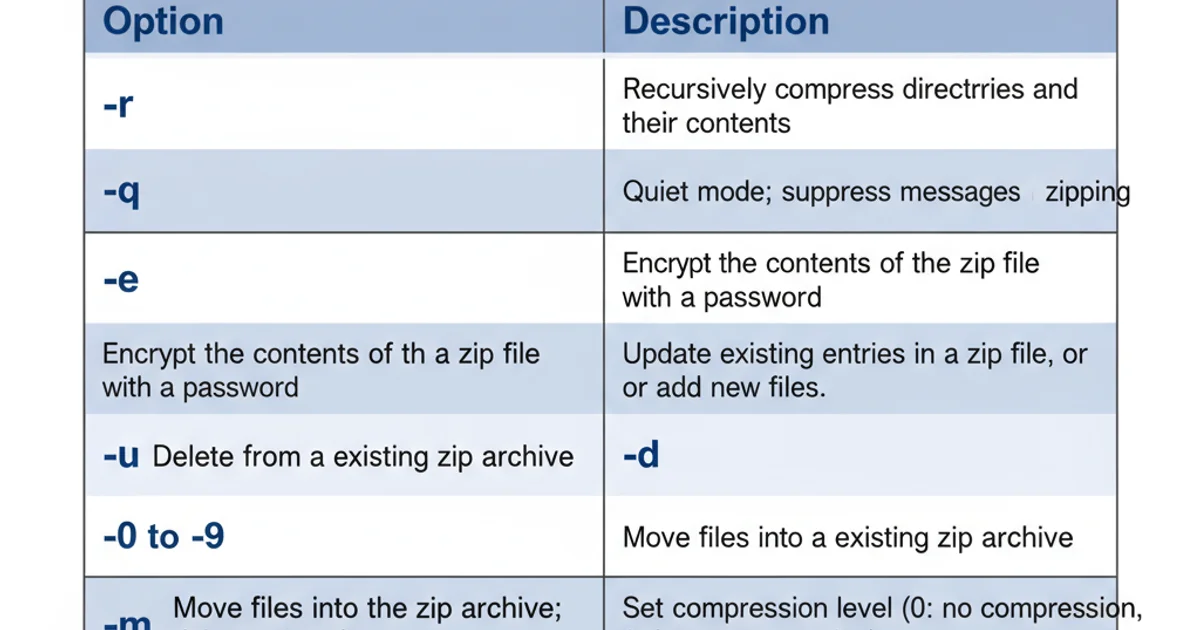How do I make a zip file on linux?
Categories:
Mastering Zip Files on Linux: A Comprehensive Guide

Learn how to create, extract, and manage zip archives efficiently using the command line on Linux systems.
Zip files are a common way to compress and bundle multiple files and directories into a single archive. This is incredibly useful for saving disk space, organizing related files, and simplifying file transfers. On Linux, the zip and unzip commands are your primary tools for handling these archives from the command line. This guide will walk you through the essential commands and best practices for working with zip files.
Creating a Zip Archive
The zip command is used to create new zip archives. You can specify individual files, entire directories, or a combination of both. The basic syntax involves providing the desired archive name followed by the files or directories you want to include.
zip archive_name.zip file1.txt file2.jpg directory_to_compress/
Basic syntax for creating a zip archive.
.) within a directory, you might need to explicitly specify them or use a wildcard like .* carefully, as zip -r usually includes them by default when compressing a directory.flowchart TD
A[Start]
B["Specify Archive Name (e.g., my_archive.zip)"]
C["Select Files/Directories to Include"]
D["Execute `zip` command"]
E["Archive Created (my_archive.zip)"]
A --> B
B --> C
C --> D
D --> EWorkflow for creating a zip archive.
Common zip Command Options
The zip command offers several useful options to control how archives are created. Understanding these options can help you manage your archives more effectively.

Key zip command options for efficient archiving.
Compressing a Directory
To compress an entire directory, including all its subdirectories and files, use the -r (recursive) option:
zip -r my_project.zip my_project_folder/
Excluding Files/Directories
You can exclude specific files or directories using the -x option. This is particularly useful for excluding temporary files or version control directories.
zip -r my_archive.zip . -x "*.log" -x "*.tmp" -x "my_project_folder/.git/*"
Setting Compression Level
The compression level can be set from 0 (no compression, fastest) to 9 (maximum compression, slowest). The default is usually 6.
zip -r -9 high_compression.zip large_data_folder/
zip -r -0 no_compression.zip quick_transfer_folder/
Extracting Zip Archives
To unpack a zip archive, you use the unzip command. This command will extract all contents of the specified zip file into the current directory by default.
unzip archive_name.zip
Basic syntax for extracting a zip archive.
1. Extract to a Specific Directory
To extract the contents to a different directory, use the -d option followed by the target directory path. The directory must exist.
unzip archive_name.zip -d /path/to/destination/
2. List Archive Contents
Before extracting, you might want to see what's inside the zip file without actually extracting it. Use the -l option for this.
unzip -l archive_name.zip
3. Extracting Specific Files
If you only need a few files from a large archive, you can specify them after the archive name.
unzip archive_name.zip file_to_extract.txt another_file.pdf